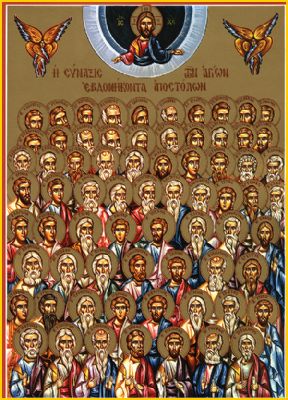From Anonimous Byzantine Chronicle #104:
The translation is based on the edition of P. Schreiner – “Short Byzantine Chronicles” (Peter Schreiner. Die byzantinischen Kleinchroniken. Teil I-III. Wien. 1977-79) – item 1 p.661-663 (Greek text) and item 3 page 135 (German translation).
Manuscripts: Athen, Benaki-Museum, 19, 417V.
Editions: Lambros, Siloge Nr. 115 (S.156-157).
Text:
1. In the year 6946 — 1437 — December 21, arrived the Patriarch of Constantinople, Joseph1, of Modon, and 29 metropolitans and bishops, and with them also other priests from the clergy of “Holy Sophia”, abbots and laymen and despot Dimitar2. They all arrived with one imperial galley and 3 of the Pope’s. They stayed 14 days in Modon.
2. In the same month, on the 28th, the emperor Cyrus John3 came from Pylos with an army. And on January 3, the patriarch left and all the members of the synod went to Pylos, where Emperor John was.
3. In 1439, November 16, arrived in Modon on the ship Gabriel Barbarigo, Emperor John and all the members of the synod. And he moved the emperor and his brother by land to Mantene.
4. And on November 23, the same year, the Latin (Frankish)4 bishop with his priests celebrated mass. And the Roman5 bishop and clergy did not arrange any mass on that very day; the Latins (Franks) and the Romans make only a hug in the Latin meat. And on the 24th of this month, in the church of Saint John the Theologian, the Roman bishop Josephus, with the secular name Kontaratos, celebrated mass, and all the clergy and the whole city, who live inside and from the surrounding area, Latins and Romans. And they also took consecrated bread – the commandant of the fortress and all the servants and their wives, in the same way as the Romans.
5. The reconciliation of the churches took place in the year 14396, during the happy Pope of Rome, Eugenius.
6. The Patriarch of Constantinople died in Florence,
7. and Metropolitan of Sardis.
8. The Latins separated from us and were excommunicated in the year 62867.
Notes:
1. Patriarch Joseph II Shishman (1416-1439).
2. Brother of the Byzantine Emperor John VIII.
3. Emperor John VIII Paleologus (1425-1448).
4. In the Greek text the Latins are called Franks.
5. Schreiner has Roman, which creates some confusion. During the Middle Ages, foreign authors (including Bulgarian) usually called the Byzantines “Greeks”. The Byzantines themselves, who were considered the successors of the Eastern Roman Empire, were called Romans. To avoid confusion in the Bulgarian language, the Byzantines are usually referred to as Romai instead of Romans.
6. It is about the concluded ecclesiastical union of the Ferrero-Florentine Council (ecumenical council of the Roman Catholic church, 1438–45).
7. We are talking about the Great Schism that occurred in 1054, during which the Eastern and Western churches split.
Photo: Icon of the 70 Apostles












